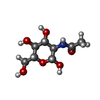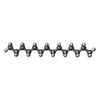[English] 日本語
 Yorodumi
Yorodumi- PDB-8xlr: Cryo-EM structure of Ca2+-bound TMEM16A in complex with Tamsulosin -
+ Open data
Open data
- Basic information
Basic information
| Entry | Database: PDB / ID: 8xlr | ||||||
|---|---|---|---|---|---|---|---|
| Title | Cryo-EM structure of Ca2+-bound TMEM16A in complex with Tamsulosin | ||||||
 Components Components | Anoctamin-1 | ||||||
 Keywords Keywords | LIPID BINDING PROTEIN / Inhibitor / Modulator / Complex / Ion channel | ||||||
| Function / homology |  Function and homology information Function and homology informationglial cell projection elongation / trachea development / mucus secretion / intracellularly calcium-gated chloride channel activity / voltage-gated chloride channel activity / Stimuli-sensing channels / chloride transport / chloride channel activity / detection of temperature stimulus involved in sensory perception of pain / chloride channel complex ...glial cell projection elongation / trachea development / mucus secretion / intracellularly calcium-gated chloride channel activity / voltage-gated chloride channel activity / Stimuli-sensing channels / chloride transport / chloride channel activity / detection of temperature stimulus involved in sensory perception of pain / chloride channel complex / positive regulation of insulin secretion involved in cellular response to glucose stimulus / chloride transmembrane transport / regulation of membrane potential / cell projection / establishment of localization in cell / cellular response to heat / presynaptic membrane / phospholipase C-activating G protein-coupled receptor signaling pathway / apical plasma membrane / external side of plasma membrane / glutamatergic synapse / protein homodimerization activity / metal ion binding / identical protein binding / plasma membrane Similarity search - Function | ||||||
| Biological species |  | ||||||
| Method | ELECTRON MICROSCOPY / single particle reconstruction / Resolution: 2.93 Å | ||||||
 Authors Authors | Li, H.L. / Li, S.L. / Li, S. | ||||||
| Funding support |  China, 1items China, 1items
| ||||||
 Citation Citation |  Journal: Proc Natl Acad Sci U S A / Year: 2025 Journal: Proc Natl Acad Sci U S A / Year: 2025Title: Tamsulosin ameliorates bone loss by inhibiting the release of Cl through wedging into an allosteric site of TMEM16A. Authors: Shiliang Li / Weijia Sun / Shuang Li / Lili Zhu / Shuai Guo / Jiaqi He / Yuheng Li / Chaoquan Tian / Zhenjiang Zhao / Tao Yu / Jianwei Li / Yiqing Zhang / Youlong Hai / Jiawen Wang / Yongjun ...Authors: Shiliang Li / Weijia Sun / Shuang Li / Lili Zhu / Shuai Guo / Jiaqi He / Yuheng Li / Chaoquan Tian / Zhenjiang Zhao / Tao Yu / Jianwei Li / Yiqing Zhang / Youlong Hai / Jiawen Wang / Yongjun Zheng / Rui Wang / Xiaoyong Hu / Shukuan Ling / Honglin Li / Yingxian Li /  Abstract: TMEM16A, a key calcium-activated chloride channel, is crucial for many physiological and pathological processes such as cancer, hypertension, and osteoporosis, etc. However, the regulatory mechanism ...TMEM16A, a key calcium-activated chloride channel, is crucial for many physiological and pathological processes such as cancer, hypertension, and osteoporosis, etc. However, the regulatory mechanism of TMEM16A is poorly understood, limiting the discovery of effective modulators. Here, we unveil an allosteric gating mechanism by presenting a high-resolution cryo-EM structure of TMEM16A in complex with a channel inhibitor that we identified, Tamsulosin, which is resolved at 2.93 Å. Tamsulosin wedges itself into a pocket within the extracellular domain of TMEM16A, surrounded by α1-α2, α5-α6, and α9-α10 loops. This binding stabilizes a transient preopen conformation of TMEM16A, which is activated by Ca ions while still preserving a closed pore to prevent Cl permeation. Validation of this binding site through computational, electrophysiological, and functional experiments, along with site-directed mutagenesis, confirmed the pivotal roles of the pocket-lining residues R605 and E624 on α5-α6 loop in modulating Tamsulosin binding and pore activity. Tamsulosin induces significant positional shifts in extracellular loops, particularly the α5-α6 loop, which moves toward the extracellular exit of the pore, leading to noticeable structural rearrangements in pore-lining helices. The hinges induced by P595 in α5 and G711 in α7 introduce flexibility to the transmembrane helices, orienting Y593 to collaborate with I641 in effectively gating the preopening pore. Notably, Tamsulosin demonstrates significant antiosteoporotic effects by inhibiting TMEM16A, suggesting potential for its repurposing in new therapeutic indications. Our study not only enhances our understanding of the gating mechanism of TMEM16A inhibition but also facilitates structure-based drug design targeting TMEM16A. | ||||||
| History |
|
- Structure visualization
Structure visualization
| Structure viewer | Molecule:  Molmil Molmil Jmol/JSmol Jmol/JSmol |
|---|
- Downloads & links
Downloads & links
- Download
Download
| PDBx/mmCIF format |  8xlr.cif.gz 8xlr.cif.gz | 338.5 KB | Display |  PDBx/mmCIF format PDBx/mmCIF format |
|---|---|---|---|---|
| PDB format |  pdb8xlr.ent.gz pdb8xlr.ent.gz | 274.1 KB | Display |  PDB format PDB format |
| PDBx/mmJSON format |  8xlr.json.gz 8xlr.json.gz | Tree view |  PDBx/mmJSON format PDBx/mmJSON format | |
| Others |  Other downloads Other downloads |
-Validation report
| Arichive directory |  https://data.pdbj.org/pub/pdb/validation_reports/xl/8xlr https://data.pdbj.org/pub/pdb/validation_reports/xl/8xlr ftp://data.pdbj.org/pub/pdb/validation_reports/xl/8xlr ftp://data.pdbj.org/pub/pdb/validation_reports/xl/8xlr | HTTPS FTP |
|---|
-Related structure data
| Related structure data |  38456MC M: map data used to model this data C: citing same article ( |
|---|---|
| Similar structure data | Similarity search - Function & homology  F&H Search F&H Search |
- Links
Links
- Assembly
Assembly
| Deposited unit | 
|
|---|---|
| 1 |
|
- Components
Components
-Protein / Sugars , 2 types, 10 molecules AB

| #1: Protein | Mass: 111058.992 Da / Num. of mol.: 2 Source method: isolated from a genetically manipulated source Source: (gene. exp.)   Homo sapiens (human) / References: UniProt: Q8BHY3 Homo sapiens (human) / References: UniProt: Q8BHY3#2: Sugar | ChemComp-NAG / |
|---|
-Non-polymers , 4 types, 58 molecules 






| #3: Chemical | ChemComp-C14 / #4: Chemical | ChemComp-CA / #5: Chemical | #6: Chemical | |
|---|
-Details
| Has ligand of interest | Y |
|---|---|
| Has protein modification | Y |
-Experimental details
-Experiment
| Experiment | Method: ELECTRON MICROSCOPY |
|---|---|
| EM experiment | Aggregation state: PARTICLE / 3D reconstruction method: single particle reconstruction |
- Sample preparation
Sample preparation
| Component | Name: Structure of Tamsulosin- and calcium-bound mTMEM16A chloride channel Type: COMPLEX / Entity ID: #1 / Source: RECOMBINANT | ||||||||||||||||||||
|---|---|---|---|---|---|---|---|---|---|---|---|---|---|---|---|---|---|---|---|---|---|
| Source (natural) | Organism:  | ||||||||||||||||||||
| Source (recombinant) | Organism:  Homo sapiens (human) Homo sapiens (human) | ||||||||||||||||||||
| Buffer solution | pH: 7.5 | ||||||||||||||||||||
| Buffer component |
| ||||||||||||||||||||
| Specimen | Conc.: 4 mg/ml / Embedding applied: NO / Shadowing applied: NO / Staining applied: NO / Vitrification applied: NO | ||||||||||||||||||||
| Specimen support | Grid mesh size: 300 divisions/in. / Grid type: Quantifoil R1.2/1.3 |
- Electron microscopy imaging
Electron microscopy imaging
| Experimental equipment |  Model: Titan Krios / Image courtesy: FEI Company |
|---|---|
| Microscopy | Model: FEI TITAN KRIOS |
| Electron gun | Electron source:  FIELD EMISSION GUN / Accelerating voltage: 300 kV / Illumination mode: FLOOD BEAM FIELD EMISSION GUN / Accelerating voltage: 300 kV / Illumination mode: FLOOD BEAM |
| Electron lens | Mode: BRIGHT FIELD / Nominal defocus max: 2000 nm / Nominal defocus min: 1000 nm |
| Image recording | Electron dose: 50 e/Å2 / Film or detector model: GATAN K3 BIOQUANTUM (6k x 4k) |
- Processing
Processing
| EM software | Name: PHENIX / Version: 1.20.1_4487: / Category: model refinement | ||||||||||||||||||||||||
|---|---|---|---|---|---|---|---|---|---|---|---|---|---|---|---|---|---|---|---|---|---|---|---|---|---|
| CTF correction | Type: PHASE FLIPPING AND AMPLITUDE CORRECTION | ||||||||||||||||||||||||
| 3D reconstruction | Resolution: 2.93 Å / Resolution method: FSC 0.143 CUT-OFF / Num. of particles: 12322 / Symmetry type: POINT | ||||||||||||||||||||||||
| Atomic model building | Protocol: AB INITIO MODEL | ||||||||||||||||||||||||
| Refine LS restraints |
|
 Movie
Movie Controller
Controller


 PDBj
PDBj




